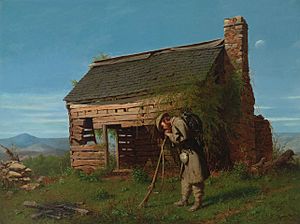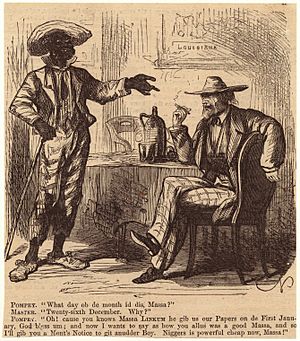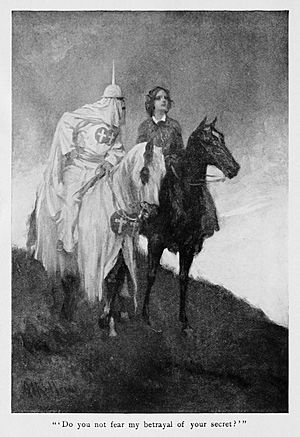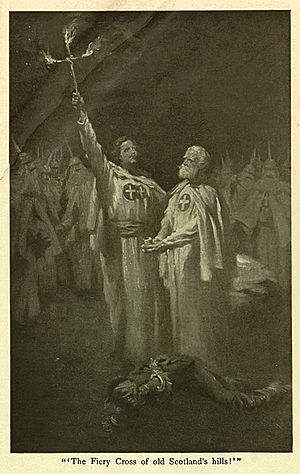Lost Cause of the Confederacy facts for kids
The Lost Cause of the Confederacy is a way of thinking about the American Civil War that started after the war ended. It's a story that says the Southern states (the Confederacy) fought for good reasons, like defending their way of life, and not because of slavery. This idea also says that the Confederate soldiers were very brave and heroic.
People who believed in the Lost Cause often praised the old Southern culture, which included ideas about honor and good manners. They claimed that enslaved people were treated well and were happy. This is very different from what Confederate leaders themselves said at the time, like in the Cornerstone Speech, which clearly stated slavery was the reason for their actions.
Instead, Lost Cause supporters said the war was about "states' rights" and protecting their farming economy from the North. They believed the North won only because it had more people and factories, not because the North was morally right or had better soldiers. However, most historians today strongly disagree. They agree that slavery was the main reason the war started.
The Lost Cause idea became very popular during two main times: around the early 1900s, when people wanted to remember the Confederate soldiers, and again in the 1950s and 1960s during the Civil Rights Movement. Groups like the United Daughters of the Confederacy and Sons of Confederate Veterans built many monuments and wrote history textbooks. They wanted white Southerners to believe their version of the war, which helped support unfair Jim Crow laws and the idea of white supremacy. White supremacy, the belief that white people are better than others, is a key part of the Lost Cause story.
Contents
Where the Lost Cause Idea Came From
The Lost Cause idea mainly argues that slavery was not the main reason for the Civil War. This goes against what the Southern states said when they left the Union. Each state wrote down why it was seceding, and many Confederate leaders, like Vice President Alexander H. Stephens, spoke about slavery as the main reason.
The Lost Cause story instead said that the Southern states left to protect their way of life from the North. They claimed this was about "states' rights" and that states had the right to leave the United States. The North strongly disagreed with this idea.
The Lost Cause also said that the South was more religious and had better Christian values than the North. It even claimed that slavery was good, saying it taught enslaved people Christianity and made them more "civilized." Stories were told about happy enslaved people to make slavery seem okay. Groups like the United Daughters of the Confederacy even created committees for "Faithful Slave Memorials." These stories tried to explain slavery to people in the North.
When explaining why the South lost the war, the Lost Cause story said it was only because the North had many more soldiers and factories. They claimed the South had better leaders and fighters, but they were simply outnumbered. For example, in 1863, the Union had more than twice as many soldiers as the Confederacy and three times more money in banks.
History of the Lost Cause
After the Confederacy lost the war, many white Southerners felt very sad and defeated. They had believed their military traditions would help them win. To feel better, many started to say they lost because of things they couldn't control, like the North's huge size and power.
University of Virginia professor Gary W. Gallagher explained that those who created the Lost Cause wanted to make sense of their defeat. They wanted to find something positive in their failure and give future generations of white Southerners a "correct" story of the war.
The Lost Cause became an important part of bringing the North and South back together around 1900. The United Daughters of the Confederacy has been a major group connected to the Lost Cause for over 100 years.
Historian Rollin G. Osterweis described the writings of the Lost Cause. He said they painted a picture of the past with brave plantation owners, elegant Southern women, and kind Confederate soldiers. These stories helped white Southerners deal with their broken society and remember the ideals of the Old South.
Gaines Foster, a history professor, noted that historians generally agree on the role the Lost Cause played. He said that white Southerners worked hard to celebrate Confederate leaders and soldiers, stressing that they had kept their honor.
The name "Lost Cause" first appeared in an 1866 book by Edward A. Pollard called The Lost Cause: A New Southern History of the War of the Confederates. Pollard wrote about many of the Lost Cause ideas. He said slavery was not important in starting the war and even claimed it improved the lives of African people.
However, it was General Jubal Early's articles in the 1870s that really made the Lost Cause a lasting idea. In 1881, former Confederate President Jefferson Davis published The Rise and Fall of the Confederate Government. In this book, Davis blamed the North for the war's violence and destruction. He said the North fought "with a ferocity that disregarded all the laws of civilized warfare." This book helped justify the Southern side and tried to separate it from slavery.
General Robert E. Lee also contributed to these ideas. In his farewell message to his soldiers, he spoke about the "overwhelming resources and numbers" they had fought against. Lee wanted to show the huge difference in strength between the two armies. He believed it would be hard for people to understand how much the South was up against. These ideas became central to the Lost Cause writers.
In 1868, Union General George Henry Thomas, who was from Virginia, noticed that former Confederates were trying to make the Confederacy look good.
Groups like the United Confederate Veterans and the United Daughters of the Confederacy used Lost Cause ideas to help white Southerners deal with changes after the war, especially during Reconstruction. These groups still exist today.
In 1879, John McElroy wrote Andersonville: A Story of Rebel Military Prisons, which criticized how the Confederacy treated prisoners. He noted that criticizing the praised Confederates was not popular.
In 1907, Hunter Holmes McGuire, a doctor for Confederate General Stonewall Jackson, published a book supporting Lost Cause ideas. It claimed that slavery was not the cause of the war and that the North started it. The book sold out quickly.
Bringing North and South Together
Historian Alan T. Nolan says the Lost Cause helped bring the North and South back together. He quotes historian Gaines M. Foster, who wrote that respect from former enemies and Northern publishers made it easier for Southerners to accept being part of a reunited nation.
Nolan also pointed out that this reunion was mainly for white people. He said that African Americans were "sacrificed" for this reunion.
Historian Caroline Janney stated that the Lost Cause helped white Southerners who feared being dishonored by their defeat. It was largely accepted by white Americans who found it useful for bringing the North and South together.
Yale historian David W. Blight wrote that the Lost Cause became a key part of national reconciliation. It gave white Southerners a way to feel proud of their Southern identity and also their American identity. By the 1890s, Confederate memories focused less on sadness and more on providing a set of traditions that could help the whole country deal with social and economic changes.
Historian William Tynes Cowa said that the Lost Cause was part of a bigger plan to reunite the North and South after the Civil War. He noted a common image in stories: a rich Northern man marrying a poor Southern woman, symbolizing a happy national reunion.
Historian and journalist Bruce Catton believed the Lost Cause myth helped achieve peace between the North and South. He said it made the conflict less explosive and more like a part of American legend and romance.
The "New South"
Historians say the "Lost Cause" helped white Southerners adjust to their new situation and move into what was called "the New South." For example, the Confederate Memorial Literary Society in Richmond, Virginia, founded a museum to defend the Confederate cause.
This museum focused on military sacrifice rather than complaints about the North. This helped bring the North and South together. By showing slavery as kind, the museum's exhibits supported the idea that Jim Crow laws were a good solution to racial problems. By praising the common soldier, the museum also helped people accept new industries and businesses in the South.
Historian Jacquelyn Dowd Hall noted that the Lost Cause idea was fully developed around 1900. She said that the Lost Cause story left out the harsh realities of slavery for African Americans and their fight for freedom. It also ignored the different views among white Southerners themselves.
Statues by Moses Jacob Ezekiel
Moses Jacob Ezekiel was a sculptor from Virginia who fought in the Civil War. From his studio in Rome, he created many statues of Confederate "heroes." These statues celebrated the Lost Cause and set an example for building Confederate monuments in the early 1900s.
Journalist Lara Moehlman said that Ezekiel's work helps create a sympathetic view of the Civil War. His Confederate statues include:
- Virginia Mourning Her Dead (1903): This statue honors students who died at the Battle of New Market.
- Statue of Stonewall Jackson (1910): Located in Charleston, West Virginia.
- Southern, also called The Lookout (1910): In the Confederate Cemetery on Johnson's Island, Ohio.
- Tyler Confederate Memorial Gateway (1913): In Hickman, Kentucky.
- Statue of John Warwick Daniel (around 1913): In Lynchburg, Virginia.
- Confederate Memorial (1914): In Arlington National Cemetery, Virginia. Ezekiel called this statue New South. It shows a woman protecting Black figures below, implying that enslaved people supported the Confederacy. Ezekiel wanted to correct what he called "lies" about the South and slavery. His descendant, Judith Ezekiel, has called for its removal, saying it is "revisionist history of racist America."
Kali Holloway, who works to remove Confederate monuments, said that Ezekiel's statues were part of a plan to frighten Black Americans, make slavery seem romantic, and spread a false story about the Confederacy. She said these monuments helped establish Jim Crow laws.
Works of Thomas Dixon Jr.
Thomas Dixon Jr. (1864–1946) was a Southern writer and speaker who did a lot to spread the Lost Cause idea.
Dixon believed that white people would win any "race war" because they had "3,000 years of civilization." He thought educating African Americans was useless and even dangerous. He worked to spread a pro-Southern view of the Reconstruction period across the country. He wanted to fight against popular stories like Uncle Tom's Cabin, which showed Southerners as cruel.
Dixon was a very popular speaker, often drawing huge crowds. Between 1899 and 1903, over 5 million people heard him speak. His play The Clansman was seen by over 4 million people.
After seeing a play based on Uncle Tom's Cabin, Dixon decided to write a series of novels about the Reconstruction period. These were The Leopard's Spots (1902), The Clansman (1905), and The Traitor (1907). In these books, he showed a battle between Black and white people, suggesting that if white leaders didn't solve the "Negro Problem," there would be a total race war. Dixon also wrote novels about Abraham Lincoln, Robert E. Lee, and Jefferson Davis.
Dixon's novels were very popular because they dealt with issues important to people who had lived through the Civil War and Reconstruction. His writing helped him become a respected voice for those with strong feelings.
His most popular novels were The Leopard's Spots and The Clansman. The movie The Birth of a Nation (1915) was based on The Clansman. It was the first film shown in the White House.
From the 20th Century to Today
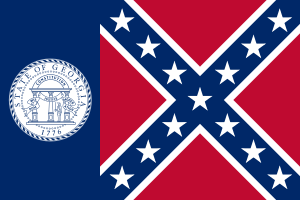
The main ideas of the Lost Cause are still believed by some people in the South today. These ideas often come up during arguments about displaying the Confederate flag or state flags that include it. The Sons of Confederate Veterans (SCV) group, which strongly defends the flag, continues to use the Lost Cause historical ideas.
The Confederacy used several flags during the war. Since the war ended, people have continued to use Confederate flags, which has caused a lot of debate. The former state flag of Mississippi, adopted in 1894, included the Confederate battle flag. It was changed in 2020 during the George Floyd protests. The city flag of Trenton, Georgia, still includes the Confederate battle flag.
In 2015, the Supreme Court of the United States ruled that Texas could refuse a request from the SCV to put a Confederate battle flag on license plates.
In October 2015, a geography textbook in Texas caused outrage because it described enslaved people as "immigrants" and "workers." The publisher, McGraw-Hill, said it would change the wording.
Religious Ideas in the Lost Cause
Charles Wilson says that many white Southerners, who were often religious Protestants, looked for religious reasons for the Confederacy's defeat. They felt that losing the war was God's punishment for their sins. Because of this belief, they turned more and more to religion for comfort.
After the war, a special "civil religion" developed in the South, full of symbols and rituals. Ministers were key in this new religion. Wilson says that ministers created Lost Cause rituals that celebrated their regional beliefs. They used the Lost Cause to warn Southerners about losing their past goodness, encourage moral improvement, and teach young people about Southern traditions.
White Southerners tried to defend their beliefs on a religious and cultural level, since they could no longer defend them politically after their defeat. The Lost Cause, seen as a defeat in a "holy war," left Southerners feeling guilt and doubt. They dealt with this by forming a unique Southern sense of tragedy in history.
In South Carolina in 1876, white conservative Democrats used the Lost Cause story to win elections. They called their fight a religious struggle between good and evil. Across the South, the Democrats who ended Reconstruction were often called "Redeemers," which is a religious term.
Gender Roles and the Lost Cause
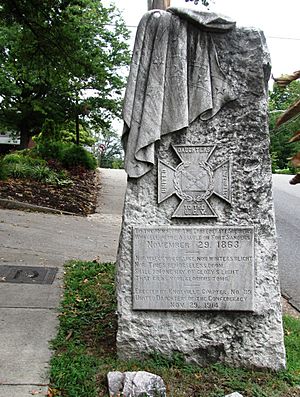
Among those who wrote about the Lost Cause, the roles of men and women were discussed. Men usually honored women for their loyalty during the war. However, women had a different view, emphasizing their own actions and leadership. They explained that when men left for war, women took charge, found food, used old skills like spinning, and managed farms. They faced dangers without men to protect them.
The Lost Cause ideas and the building of monuments were mainly done by Southern women, especially through the United Daughters of the Confederacy (UDC).
Remembering the Confederate dead was a major activity for Southerners who believed in the Lost Cause. UDC chapters played a central role in this. The UDC was very powerful in the South in the early 1900s. Their main job was to preserve the memory of Confederate soldiers, especially the men who died in the war. Their long-term impact was to promote the Lost Cause image of the old Southern plantation society as a perfect place that was destroyed by Northern changes, which also changed traditional gender roles.
Southern states created their own pension systems for veterans and their families, especially widows, since they couldn't get federal pensions. These pensions were meant to honor the Lost Cause and help with poverty. Men applying for pensions had to show they were still loyal to the "lost cause." Women were rejected if their moral reputation was questioned.
In Natchez, Mississippi, local newspapers and veterans helped keep the Lost Cause alive. However, wealthy white women were key in creating memorials, like the Civil War Monument dedicated in 1890. The Lost Cause allowed women who didn't fight to claim a central role in how Southern history was remembered.
The UDC was very important, but many other women's clubs also focused on history. Historian W. Fitzhugh Brundage noted that women were much more interested in historical organizations than men. Men often joined secret societies and focused on sports, politics, and money to prove their manhood. Brundage noted that after women gained the right to vote in 1920, the historical role of women's organizations decreased.
In their most active period, the first two decades of the 1900s, Brundage concluded that these women shaped how white people remembered history. They explained and sometimes made mysterious the reasons for white supremacy and power in the South. Even without the right to vote, organized white women played a major role in creating the historical memory that shaped Southern politics and public life.
Main Ideas of the Lost Cause
Here are some of the main ideas of the Lost Cause movement:
- States had the right to leave the federal union, just as they chose to join it.
- The main reason the Southern states left the Union was to defend "states' rights," not to keep slavery.
- Leaving the Union was fair and allowed by the Constitution. It was a response to the North's actions against the South's way of life, which included slavery. The South was fighting for its independence.
- The North did not attack the South to end slavery. Its reasons were about money and power.
- Slavery was not only a mild system but a "positive good." It was not based on greed. Enslaved people were generally happy and loyal to their kind masters. Slavery was good for both Black and white people. The lives of enslaved Black people were supposedly better than they would have been in Africa or as free Black people in the North.
- The Lost Cause describes a Southern ideal of brave, honorable gentlemen, especially Confederate fighters like Nathan Bedford Forrest and John Singleton Mosby.
- Confederate generals like Robert E. Lee, Albert Sidney Johnston, and Stonewall Jackson were seen as noble and fought bravely. Most Northern generals were shown as cruel, destroying Southern property, like Sherman's March to the Sea. Union General Ulysses S. Grant was often portrayed as an alcoholic.
- The South's losses in battles were unavoidable because the North had more resources and soldiers. Sometimes, losses were blamed on betrayal or mistakes by Lee's officers, like General James Longstreet, who was criticized for doubting Lee at Gettysburg.
- The Lost Cause mainly focuses on Lee and the fighting in Virginia, Maryland, and Pennsylvania. It often sees Gettysburg as the turning point of the war, ignoring Union victories in other areas.
- General Sherman destroyed property out of meanness, not for military reasons.
- Giving the right to vote to newly freed enslaved people would only lead to chaos. They were seen as unable to vote wisely and easily tricked. Reconstruction was seen as a disaster, only helping greedy Northerners. It took great effort by Southern gentlemen to bring back order through white control.
- The way Southern society was organized, with its customs, was seen as being in line with Christian values and God's will.
Symbols of the Lost Cause
Confederate Generals
The most powerful symbols of the Lost Cause were generals like Robert E. Lee, Albert Sidney Johnston, and the event of Pickett's Charge. David Ulbrich wrote that Lee became almost god-like in Southern culture after the war. He was remembered as a leader his soldiers would follow anywhere. Lee became a symbol of the Lost Cause and the ideal Southern gentleman. His brilliant tactics became legendary. Even though he took responsibility for the defeat at Gettysburg, Southerners rarely criticized Lee.
In the view of Jubal Early, General Longstreet was the main villain among Lee's officers. Early's writings blamed Longstreet for the Confederate defeat at Gettysburg, saying he failed to attack early on July 2, 1863. However, Lee himself never said he was unhappy with Longstreet's actions that day. Longstreet was often disliked by Southern veterans because he worked with US President Ulysses S. Grant after the war and joined the Republican Party. Grant disagreed with the Lost Cause ideas, saying in 1878 that the South was not simply overwhelmed by numbers. He noted that the "4,000,000 of negroes" who worked on farms and supported the armies were not counted as a Southern advantage.
"War of Northern Aggression"
A key part of the Lost Cause was the idea that leaving the Union was legal. If it wasn't, then all Confederate leaders would be seen as traitors. To make the Confederacy's actions seem right, Lost Cause thinkers questioned the US government and Abraham Lincoln's actions as president. They claimed Lincoln won the 1860 election with a minority of the popular vote and that his stance on slavery was unclear.
These claims, though proven false, led to the belief that the North started the Civil War. This is why some people call it "The War of Northern Aggression."
Thomas Dixon Jr.'s Novels
The Leopard's Spots
On the title page, Dixon quoted a Bible verse: "Can the Ethiopian change his color, or the Leopard his spots?" He used this to argue that Black people could not change their nature. The novel aimed to show that the "Anglo-Saxon" (white) race was superior and that Black people should either be controlled by white people or separated from them.
According to historian Richard Allen Cook, Dixon believed that Black people were "a brute, not a citizen." Dixon said in 1902, "The negro is a human donkey. You can train him, but you can't make of him a horse." Dixon described the "freed negro" as a growing threat that overshadowed the South's problems, bringing a "black death" to the land. Using characters from Uncle Tom's Cabin, he showed "happy slaves" who, once free and influenced by Northerners, became unproductive and disrespectful. He also believed that freedmen constantly sought relationships with white women. In Dixon's work, the heroic Ku Klux Klan protected white women.
The novel was very popular, selling over 100,000 copies quickly and eventually over a million. It was translated into many languages, making Dixon famous worldwide.
The Clansman
In The Clansman, Dixon claimed he was telling the "true story" of the Ku Klux Klan, which he said overturned the Reconstruction government.
Abraham Lincoln is shown as a kind man trying to keep his policies despite pressure to be harsh on the South. Reconstruction is portrayed as an attempt by a Northern politician, Augustus Stoneman (based on Thaddeus Stevens), to keep the Republican Party in power by getting Black votes in the South. Stoneman's anger towards former slave owners grows after Lincoln's assassination. His programs take land from white people and give it to former enslaved people. The book claims that former enslaved people were taught they were better than their former owners and should rise against them. These supposed injustices led to the creation of the Ku Klux Klan. Dixon's father was in the Klan, and his uncle, Leroy McAfee, a regional Klan leader, is honored in the book's dedication.
The book shows the Klan burning crosses, which was an idea Dixon added. The original Klan did not do this, but later Klan groups adopted it.
The book also describes the poverty, shame, and suffering of Southerners at the hands of Black people and dishonest Northerners. Martial law is declared, and US troops are sent in, as happened during Reconstruction. The book claims the South won when the Klan defeated the federal troops.
Dixon rewrote The Clansman as a play, which was also a big success. The movie Birth of a Nation is based on this play.
The Birth of a Nation
D. W. Griffith's very successful film The Birth of a Nation (1915) also helped spread the Lost Cause idea. It was based on Dixon's novel. Blight wrote that Dixon's harsh view that Black people caused the Civil War, and that Northern ideas during Reconstruction failed to understand that freedom led Black people into "barbarism," shaped the story of heroic white vigilantes in the South. Reluctantly, Klansmen had to take the law into their own hands to save white Southern women from Black men.
Dixon's vision captured the feelings of many and created a shared memory that the war might have been lost, but Reconstruction was won by the South and a reunited nation. The Klan, riding as masked cavalry, stopped corrupt government, prevented "Negro rule," and most importantly, saved white supremacy.
The film showed the Klan as continuing the noble traditions of the old South and the brave Confederate soldier. It showed them defending Southern culture and women from freedmen and Northern "carpetbaggers" during Reconstruction. Dixon's story was so widely accepted that the film is credited with helping the Klan revive in the 1910s and 1920s. The film's legacy is huge in the history of American racism. Even the famous cross burnings of the KKK came from Dixon's novel and the film.
Later Books and Films
The romantic view of the Lost Cause is seen in films like The Birth of a Nation, Gone With the Wind, Song of the South, and Tennessee Johnson. These films often show the old South as a beautiful place with happy enslaved people, kind slave owners, and villainous Northerners.
Literature After the 1920s
In his novels about the Sartoris family, William Faulkner wrote about those who supported the Lost Cause. However, he suggested that the ideal itself was wrong and outdated.
The Confederate Veteran, a monthly magazine published from 1893 to 1932, helped make its publisher, Sumner Archibald Cunningham, a leader of the Lost Cause movement.
Gone with the Wind
The Lost Cause view reached millions of Americans through Margaret Mitchell's best-selling 1936 novel Gone with the Wind and the Oscar-winning 1939 film. Helen Taylor wrote that Gone with the Wind created a lasting feeling of longing for the glamorous Southern plantation house and its structured society where enslaved people were "family." It spoke powerfully about big themes like war, love, and death.
Blight also wrote that from these Lost Cause stories, a reunited America emerged feeling pure and guiltless. The side that lost was especially sure that its cause was true and good. One idea the Lost Cause taught was that even when Americans lose, they win. This was the message in Margaret Mitchell's character Scarlett O'Hara in Gone With the Wind.
Southerners were shown as noble, heroic figures living in a doomed romantic society. They ignored realistic advice and didn't understand the risks of going to war.
Song of the South
The 1946 Disney film Song of the South combined live actors with animation. In the story, James Baskett played Uncle Remus, a former enslaved person who seems full of joy and wisdom despite having lived part of his life in slavery. Many people mistakenly think the story takes place before the Civil War and that the Black characters are enslaved. One critic said that, like other films about the old South, the enslaved people in this film are shown as good-natured, obedient, cheerful, and always willing to help white people. They are never called slaves but seem like friendly workers helping kind plantation owners. Disney has never released this film on DVD or Disney+.
Gods and Generals
The 2003 Civil War film Gods and Generals is widely seen as supporting the Lost Cause idea. It presents the Confederacy in a good light and praises Generals Jackson and Lee.
Historian Steven E. Woodworth called the movie a modern telling of Lost Cause mythology. He said it was "the most pro-Confederate film since Birth of a Nation, a true celebration of slavery and treason." Woodworth criticized the movie for showing enslaved people as "generally happy" and for not focusing enough on why Union soldiers fought. He also criticized the film for suggesting that the South was more "sincerely Christian." Woodworth concluded that the film gives a "distorted view of the Civil War" by leaving out important details.
Historian William B. Feis also criticized the director for choosing to support the "simplistic and sanitized" ideas of the Lost Cause. Film critic Roger Ebert said the movie was "a Civil War movie that Trent Lott might enjoy" and that if World War II were shown this way, there would be big problems.
Most film critics agreed that the movie had a strong "pro-Confederate slant."
Later Use of the Lost Cause
Professor Gallagher said that Douglas Southall Freeman's 1934 biography of Lee made Lee's image as a completely heroic figure very strong in American writings. In that book, Lee's officers were mainly blamed for mistakes that lost battles. While Longstreet was often blamed, others like Richard Ewell, Jubal Early, J. E. B. Stuart, A. P. Hill, and George Pickett were also criticized by Southerners to protect Lee from blame.
Hudson Strode wrote a popular three-volume biography of Confederate President Jefferson Davis. A leading scholarly journal said that Strode's book showed his political biases. It stated that Davis's enemies were shown as evil, and his friends, like Davis, were made to seem perfect. The review said the book would be enjoyed by those who strongly supported the Lost Cause.
In 2018, a Dallas newspaper editorial called the Texas Civil War Museum "a lovely bit of 'Lost Cause' propaganda."
The "Stop the Steal" movement after the 2020 United States presidential election has been seen by some as a return of the Lost Cause idea and a sign of white backlash.
What Historians Say Today
Most historians today agree that slavery was the main reason the Southern states left the Union. There were many reasons for secession, but keeping and expanding slavery was by far the most important. The confusion might come from mixing up the reasons for secession with the reasons for the war itself. Lincoln fought to keep the Union together, not to free enslaved people at first.
According to historian Kenneth M. Stampp, both sides supported states' rights or federal power only when it suited them. Stampp also pointed to Confederate Vice President Alexander Stephens's book, where Stephens first said slavery was the "cornerstone of the Confederacy" when the war began. But after the defeat, he changed his story and said the war was about states' rights. Stampp says Stephens became one of the strongest supporters of the 'Lost Cause' myth.
Similarly, historian William C. Davis explained that the Confederate Constitution protected slavery at the national level. He said this was the clearest proof that slavery, not states' rights, was at the heart of their movement.
Davis also noted that the causes and effects of the war have been changed and made into myths to fit political and social goals. Historian David Blight said that using white supremacy as both a method and a goal has been a key feature of the Lost Cause. Historian Allan Nolan wrote that the Lost Cause has created a false picture of the truth. He said it's time to understand this important part of our past without the lies and romantic feelings of the Lost Cause myth.
Historian William C. Davis called many of the myths about the war "frivolous." He said that names like the "War of Northern Aggression" and the "War Between the States" (a term coined by Alexander Stephens) were just attempts to deny that the American Civil War was truly a civil war.
Historian A. Cash Koeniger suggested that Gary Gallagher might have wrongly described films that show the Lost Cause. Koeniger wrote that Gallagher agrees that "Lost Cause themes" (except for downplaying slavery) are based on historical truths. For example, Confederate soldiers were often outnumbered and hungry, and Southern civilians suffered a lot. US forces did destroy Southern property. But whenever these points appear in films, Gallagher sees them as "celebrating" the Confederacy.
Images for kids
-
Custis Lee (1832–1913) on horseback in front of the Jefferson Davis Memorial in Richmond, Virginia, on June 3, 1907, reviewing a Confederate Reunion Parade.
-
Members of the United Daughters of the Confederacy around a Confederate monument in Lakeland, Florida, 1915.
See also
 In Spanish: Causa Perdida de la Confederación para niños
In Spanish: Causa Perdida de la Confederación para niños


